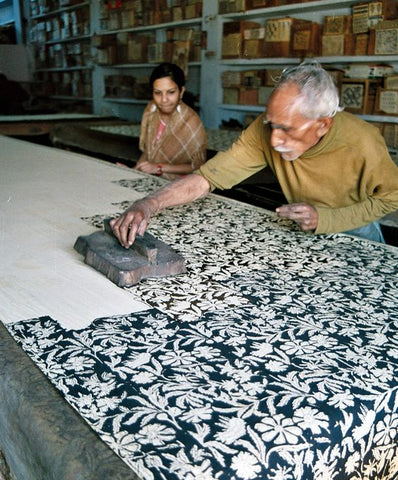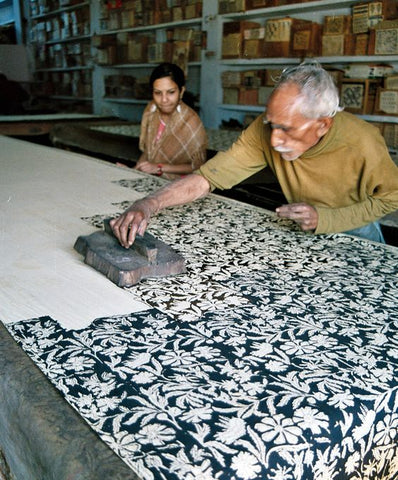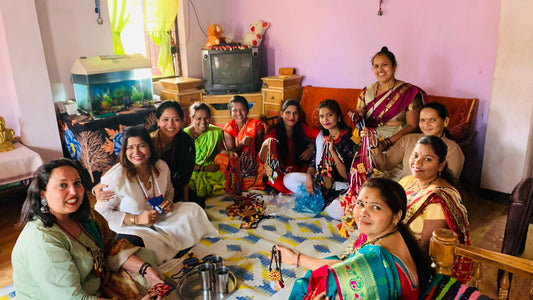India’s artistic heritage is not just etched on walls of temples or in museums—it flows through threads, prints, and pigments. Among the most soulful expressions of this heritage are our ethnic vegetable print fabrics, handcrafted by artisans who treat cloth as a sacred canvas. From the earthy tones of Kalamkari to the geometric grace of Ikkat, these textiles carry not just patterns, but stories, rituals, and rhythms of a timeless land.
Let us walk through five such exquisite art forms that keep India's handloom and handprint legacy alive:
1. Kalamkari – Storytelling with Natural Dyes
Rooted in Andhra Pradesh and Telangana, Kalamkari (from kalam meaning pen and kari meaning craft) is a hand-painted or block-printed textile art that uses only natural dyes and plant-based pigments. These fabrics often depict mythological tales from the Ramayana, Mahabharata, and Indian folklore, painstakingly painted using bamboo pens and mineral dyes.
Every Kalamkari piece is a sacred narration. It's slow art—a meditative process involving washing, sun-drying, treating the fabric with cow milk, and layering natural color. In a world of digital prints, Kalamkari remains a soulful whisper from the past.

2. Ajrak – The Ancient Geometry of Sindh
Originating from Kutch in Gujarat and the Sindh region, Ajrak is a deeply meditative block printing technique using indigo and madder dyes. What sets it apart is its intricate symmetry and geometric precision—often in indigo, deep red, black, and white.
Ajrak is not just fashion—it’s ancestral identity, worn during rituals, wrapped around shoulders during prayers, and treated as sacred by its creators. The process involves multiple stages of dyeing, resist printing, and washing—each step done with devotion and rhythm.
3. Dabu Print – The Art of Resist and Reveal
From the heartlands of Rajasthan comes Dabu, a mud-resist hand block printing technique where patterns are created using a mix of clay, gum, and natural dye. The fabric is stamped with the resist paste, then dyed, washed, and dried to reveal earthy, faded elegance.
Dabu is imperfectly perfect—its irregularities are its charm. The fabric breathes of desert winds, sun-baked earth, and the lives of artisans who imprint their soul on each piece.


4. Block Print – The Voice of Indian Villages
While block printing is widespread across India, each region lends its own character. From Bagru and Sanganer in Rajasthan to small workshops in Madhya Pradesh and Gujarat, block printing uses hand-carved wooden blocks and natural dyes to stamp repeating motifs of flowers, vines, birds, and paisleys.
This form brings playfulness and poetry to fabric. It's affordable, accessible, and deeply sustainable when rooted in vegetable dyes. A block-printed cotton dupatta can be as sacred as a temple visit for the woman who wears it.
5. Ikkat – The Woven Mirage
Unlike printed fabrics, Ikkat is a resist-dye weaving technique where the yarns are tie-dyed before weaving. Found in Telangana (Pochampally), Odisha, and Gujarat (Patola), Ikkat involves stunning precision—where patterns emerge through loom, not paint.
Ikkat feels mystical—its blurred edges, vibrant hues, and tribal aesthetics make it a favorite for sarees, dupattas, and home décor. It's a fabric that celebrates unity in imperfection.

A Celebration of Earth, Art, and Artisan
Vegetable print and handwoven ethnic fabrics are not just textiles—they are living traditions, eco-conscious art forms, and powerful tools of rural empowerment. When you wear or support these, you support natural dye practices, artisan livelihoods, sustainable fashion, and cultural preservation.
In every motif, in every shade lies the silent song of our soil.




